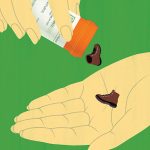Solutions
April 18, 2019

History keepers
Creating historical records, archiving photos, recording oral histories—it’s all in a program of UW Libraries with the Ethnic Heritage Council.
March 12, 2019

Abolished
How UW research convinced our state's highest court to toss out the death penalty.
March 1, 2019

Busier bees
Using teeny, tiny batteries and sensors, insects provide a valuable eye in the sky for agriculture.

Natural elixir
Spending time outside is a sure-fire way to feel better. But researchers still don't know why that is.
November 30, 2018

Safe travels
Author and traveler Chris Sanford shares 10 bits of wisdom from his book, “Staying Healthy Abroad: A Global Traveler’s Guide.”

Tech for mental health
UW Medicine researchers are exploring how a smartphone might help someone manage a severe mental illness such as schizophrenia or bipolar disorder.
August 30, 2018

New biologies
Nature is an interconnected web of life. A new Life Sciences building takes that to heart.
August 26, 2018

Sharks spin a tale
Great white sharks dive deep into the Atlantic’s clockwise-spinning warm-water whirlpools.
August 6, 2018
Diabetes nation
We talk about the state of diabetes with Ira Hirsch, the UW’s Diabetes Treatment and Teaching Chair.

Soldier Shakespeare
Acting out the Bard’s works enables veterans to access feelings of rage, isolation and grief—
and heal the invisible wounds of war.

Shooting for the stars
For 40 years, a group of Seattle-area women has helped UW students strive to be the best in science and engineering.
June 22, 2018

The Innovation File: A study in persistence
Dennis Edmondson, ’80, ’13, invented the studs inside the Nanoengineering & Sciences Building.
June 5, 2018

Coffee with a twist of tech
Paul Tupper, ’14, started Onda Origins, a Seattle-based coffee company with a technological spin, to further his environmental agenda.
June 4, 2018

Rethinking drugs
Ingrid Walker wants to change the way media and government frame our perceptions about illicit drugs, and the people who use them.

No easy tusk
Marine biologist Kristin Laidre is living her dream of studying narwhals, the mysterious 2,000-pound mammals that are notoriously tricky to find.

Drug price isn't right
There’s a new blockbuster drug that could save the lives of thousands of people with type 2 diabetes in the U.S.
April 5, 2018

International problem solvers
Outside of the classroom, UW engineering students solve problems around the world.

Genetic fortune telling
Thanks to services such as 23andMe, genetics has gone mainstream. But should you believe the hype?
March 26, 2018

From playdough to Plato
Children are by nature philosophical thinkers—ready to take on heady topics like race, fairness and human rights.
